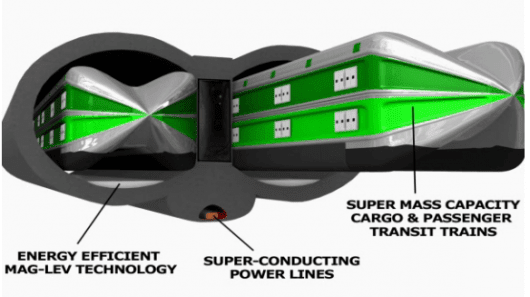Of course, if it was that simple, we’d already be blasting around the Earth at orbital speeds
In the 1800s, when pneumatic tubes shot telegrams and small items all around buildings and sometimes small cities, the future of mass transit seemed clear: we’d be firing people around through these sealed tubes at high speeds. And it turns out we’ve got the technology to do that today – mag-lev rail lines remove all rolling friction from the energy equation for a train, and accelerating them through a vacuum tunnel can eliminate wind resistance to the point where it’s theoretically possible to reach blistering speeds over 4,000 mph (6,437 km/h) using a fraction of the energy an airliner uses – and recapturing a lot of that energy upon deceleration. Ultra-fast, high efficiency ground transport is technologically within reach – so why isn’t anybody building it?
The next frontier of speed
Vacuum tube-based transport has a lot of things going for it. Speed, for one. Anyone who has spent time on a fast motorcycle knows that even without any wind, the air itself is a brutally powerful force working against your engine as you get up above 125 mph (200 km/h). In fact, air resistance is the number one problem to combat as speeds increase. Airliners have to fly 40,000 feet up in the air to take advantage of the reduced drag you get when the air thins out a bit. And even with this advantage, they still can’t cruise much faster than 570 mph (917 km/h) without being horribly inefficient.
Take air resistance and rolling resistance away by operating in a vacuum and magnetically levitating your vehicle, and you’re eliminating the biggest two hurdles to achieving extremely high speeds. And once you reach your top speed, you simply stop accelerating, apply no further energy, and coast. You lose very little speed until you reach your destination, at which point you can slow your vehicle down electromagnetically and recapture almost all the energy you put in to speed it up.
Theoretically, with the right length of vacuum tube set up, you could zoom all the way around the world in a matter of hours, nearly ten times faster than today’s airliners. Operating in a vacuum, these vehicles would make almost no sound, even as they smashed through the sound barrier, because there’d be no air for them to create sonic vibrations in. With no actual points of contact or friction with the track or tube, there would be virtually no energy lost to heat dissipation.
The vacuum-tube revolutionaries
There are no shortage of people and groups pushing for widespread adoption of vacuum tube technology as a superfast travel option – after all, with the demise of the Concorde supersonic airliner, mass global transit speeds have remained stagnant since the 1960s. Sending an e-mail from London to Beijing might be instantaneous, but the rest of the world still feels like a long way away if you have to physically travel around it.
We recently wrote about the ET3 consortium, a licensing organization that owns a number of patents in the evacuated tube transport space, Acabion’s vacuum tube streamliners, and the gigantic Startram space elevator project, which would make use of the low energy requirements of the vacuum tube maglev idea to cheaply propel various objects into orbit.
Another contender with an interesting take on the technology is Terraspan, a group that wants to combine superfast transport with the creation of a new intracontinental power grid that can make much more efficient use of the cycles of power creation and usage across a large country like the United States.
Here’s the plan – for step one, Terraspan would like to build a backbone network of underground vacuum tube train tunnels linking eastern Canada to western Mexico through the United States. Embedded in the train tunnel network would be a series of thick, superconducting energy cables that would form the heart of the first true continental power grid.
The benefits of a long-distance power grid are simple – you can take the energy produced by solar and wind producers in the arid central areas of America, and make it available to much more densely populated and power-hungry areas on the eastern and western coasts. You could also make more efficient use of power creation and usage cycles – energy that’s created in California at off-peak times can be sent across the grid to be used in peak hour in New York.
So here’s a plan that wraps up super-fast, ultra-efficient, convenient transport with smart energy usage and a tangible boost for renewable power creation schemes. Let’s go, right?
via Gizmag – Loz Blain
The Latest Streaming News: vacuum-tube trains updated minute-by-minute








